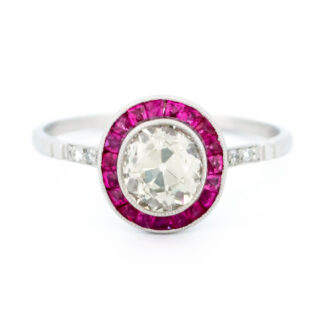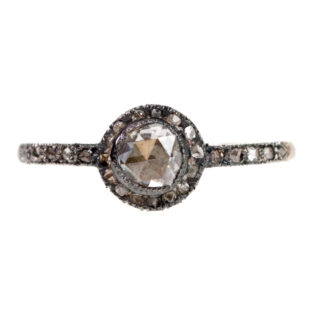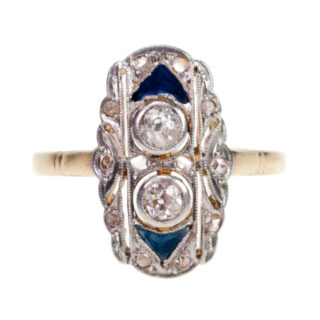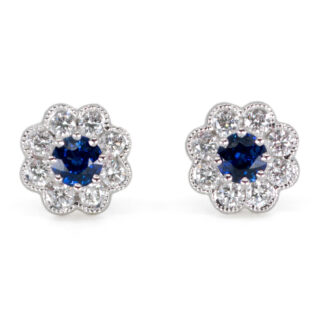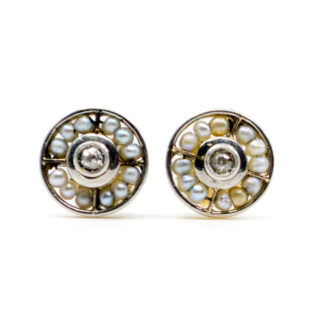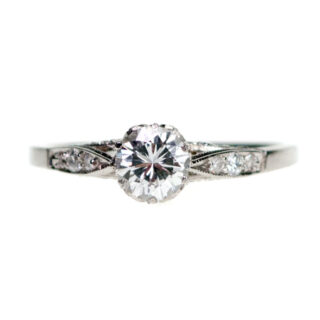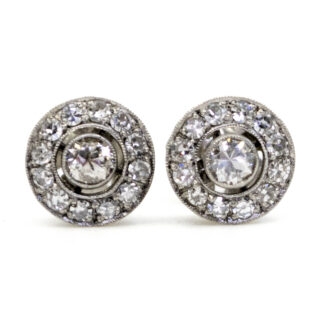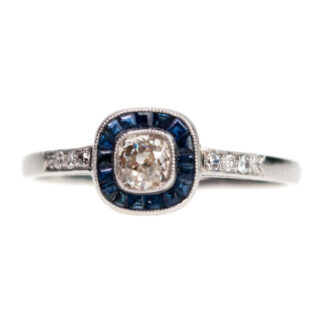These exquisite Belle-Époque pendant earrings feature two dazzling old-mine-cut diamonds totaling approx. 0.40ct. (H SI1), perfectly complemented by shimmering rose-cut diamonds. Crafted in 18k gold and platinum, these luxurious earrings are held securely in place with push-backs.
Details: tow totaling ±0.40ct. (H SI1) Old-mine-cut diamonds, Rose-cut diamonds, 18k, Platinum Earrings *.
Design Era: Belle Époque (1870-1915).
Dimensions: H 2 x L 0.5 x W 0.4 cm.
Weight in grams: 2.6.
Condition: Very good condition – slightly used with small signs of wear.
Shipping and Pickup: This delicate piece ships from our store located in the center of Amsterdam, The Netherlands. We offer both registered shipping and local pickup at our store. In the case of local pickup, any applicable shipping costs will be refunded.
About Us: Add some sparkle to your style with Binenbaum.com. We offer a stunning selection of antique and vintage jewelry that you won’t find anywhere else. From timeless rings and dazzling necklaces to unique brooches, we have something for every taste and occasion. Visit our website today and treat yourself to a piece of history.
| Design Era | |
|---|---|
| Design & Historical Context | The Belle Époque, or "Beautiful Era," was a period of prosperity and artistic flourishing that lasted from 1870 to 1915. During this time, three major jewelry design movements emerged: Art Nouveau, Arts and Crafts, and Edwardian. Art Nouveau jewelry featured organic, flowing lines and was influenced by nature, while Arts and Crafts jewelry was characterized by a focus on handcrafted techniques and a rejection of machine production. Edwardian jewelry, on the other hand, was often more ornate and decorative, reflecting the opulence of the time. The rise of movies and movie stars also had a significant impact on fashion trends during the Belle Époque, with Hollywood replacing European nobility as the source of inspiration for many people. Both handmade and machine-made jewelry were produced during this period, with the Arts and Crafts movement being the only exception, as all of its jewelry was made by hand. However, the lengthy and costly processes involved in creating Arts and Crafts jewelry meant that this design phase was relatively short-lived. |
| Key Materials | |
| Materials & Craftsmanship | Old-mine-cut diamond The old mine cut is a type of diamond cut that was popular in the 1700s and was most prevalent during the Georgian and Victorian eras. It is similar to today's cushion cut and is characterized by a squarish girdle with gently rounded corners, a high crown, a small table, and a large, flat culet. Old mine cut diamonds are known for their antique charm and character, and they are often used in vintage-style jewelry. They have a softer, more romantic look than modern diamond cuts, which tend to have more precise geometry and a higher level of brilliance. Old mine cut diamonds are typically less expensive than diamonds with more modern cuts because they require less labor and material to produce. They are often used as accent stones in jewelry designs or as the main gemstone in vintage-style pieces. Despite their lower price, old mine cut diamonds can still be beautiful and valuable, and they are a popular choice for those who appreciate the unique charm and character of antique jewelry. Rose-cut diamond The rose cut is a type of diamond cut that was popular in the 1500s and remained common during the Georgian and Victorian eras. It is characterized by a flat bottom with a dome-shaped crown that rises to a single apex, giving the diamond a shape that resembles a rose bud. Rose cut diamonds can have anywhere from 3 to 24 facets, which are small, flat surfaces that are cut into the diamond to create a specific shape and enhance its sparkle and brilliance. Unlike modern diamond cuts, such as the round brilliant or princess cut, the rose cut has a lower crown and a less brilliant appearance. It is a more primitive diamond cut that was used before the development of more advanced cutting techniques. However, it is still a popular choice for collectors of antique jewelry and for those who appreciate the timeless beauty of vintage cuts. Rose cut diamonds are typically less expensive than diamonds with more modern cuts because they require less labor and material to produce. They are often used as accent stones in jewelry designs or as the main gemstone in vintage-style pieces. Despite their lower price, rose cut diamonds can still be beautiful and valuable, and they are a popular choice for those who appreciate the unique charm and character of antique jewelry. 18k 18k gold is a type of gold alloy that is commonly used in jewelry making. It is made up of 75% gold and 25% other metals, such as copper, silver, or palladium. The addition of other metals helps to increase the durability and strength of the gold, making it more suitable for use in jewelry. 18k gold is softer and more prone to scratching than higher karat golds, such as 22k or 24k, but it is still a popular choice for jewelry because of its warm, yellow color and good resistance to tarnishing. It is also less expensive than higher karat golds due to the smaller amount of gold used in the alloy. 18k gold is a popular choice for engagement rings, wedding bands, and other fine jewelry items. Platinum Platinum is a white metallic element that is known for its strength, durability, and resistance to tarnish and corrosion. It belongs to a group of elements called the platinum group metals, which also includes osmium, iridium, palladium, rhodium, and ruthenium. Platinum is often found in nature as an alloy, which is a mixture of two or more elements. It can be mixed with other platinum group metals or with other elements such as copper, nickel, or cobalt. It wasn't until 1804 that all of the elements in the platinum group were isolated and named, with the exception of osmium, which was not isolated until 1841. Platinum is a highly prized metal that is often used in the manufacture of fine jewelry. It is malleable, meaning that it can be easily molded and shaped, and it is ductile, meaning that it can be drawn into thin wires or sheets. It is also very strong, which makes it suitable for use in a wide range of applications. Platinum is named after the Spanish word "platina," which means "little silver." It is thought to have been named this because of its white metallic luster, which is similar to that of silver. Platinum was first discovered by the Spanish conquistadors in South America, near the Pinto River in present-day Columbia. |
| Dimensions | H 2 x L 0.5 x W 0.4 cm |
| Gender | |
| Weight (in grams) | 2.6 |
| Condition | Very good condition – slightly used with small signs of wear |
Enhance the Beauty of Your Jewelry with Proper Care
Wearing your jewelry is a special way to express yourself and add a touch of personal style to any look. However, to ensure your jewelry remains in pristine condition, there are a few simple steps you need to take to keep it looking its best.
General Care Instructions:
Remove jewelry when showering or bathing, especially when at the beach, in the sea or in chlorinated water.
Avoid wearing jewelry while doing physical work such as housekeeping, gardening or exercise.
Storing your jewelry in a dry and cool place will help protect it from moisture, dirt and dust.
Keeping it away from harsh chemicals such as bleach, ammonia and chlorine will help to avoid discoloration and damage.
Cleaning your jewelry regularly with a soft cloth will help to keep it looking shiny and new.
Avoid exposing your jewelry to extreme temperatures, such as leaving it in direct sunlight or near a heater, as this can cause damage.
Handle your jewelry carefully and avoid dropping it, as this can cause the stones to loosen or the metals to scratch.
Finally, if possible, have your jewelry professionally checked and serviced. This will ensure that any potential problems are spotted and fixed before they become worse.
By following these tips, you can enjoy your precious jewelry for many years to come.
Related products
-
Binenbaum Luxe Halo Ring 6966-1885
€ 5.295,00 VAT incl. (where applicable) -
Diamond 14k Silver Antique Ring 7311-0718
€ 1.695,00Original price was: € 1.695,00.€ 1.495,00Current price is: € 1.495,00. VAT incl. (where applicable) -
Diamond Sapphire 18k Deco Ring 7331-1947
€ 1.595,00 VAT incl. (where applicable) -
Sapphire Diamond 18k Cluster Earrings 8204-0840
€ 1.495,00 VAT incl. (where applicable) -
Diamond Pearl 18k Cluster Earrings 8277-1998
€ 695,00 VAT incl. (where applicable) -
Diamond Platinum Solitaire Ring 7243-1935
€ 3.995,00 VAT incl. (where applicable) -
Diamond Platinum Cluster Earrings 4977-4675
€ 3.395,00 VAT incl. (where applicable) -
Diamond Sapphire Platinum Target Ring 6988-0010
€ 2.295,00 VAT incl. (where applicable)
- Home
- Collection
- Fine Jewelry
- Silver Jewelry
- Silverware
- Boxes
- Candlesticks
- Salt and pepper shakers
- Miniatures
- Salt cellars
- Spoon Set
- Condiments
- Frames
- Napkin Ring
- Spoon
- Oddities
- Cups
- Vases
- Cutlery
- Serving Spoon And Cake Server
- Candlesticks
- Baskets
- Hanukkiah
- Spice Tower
- Yad
- Tea Set
- Sugar Castor
- Napkin Rings
- Wine Bottle Coaster
- Wine Stopper
- Tea Pot
- Jugs
- Rattles
- Hip Flask
- Miscellaneous
- Rings 💍
- About
- Contact




